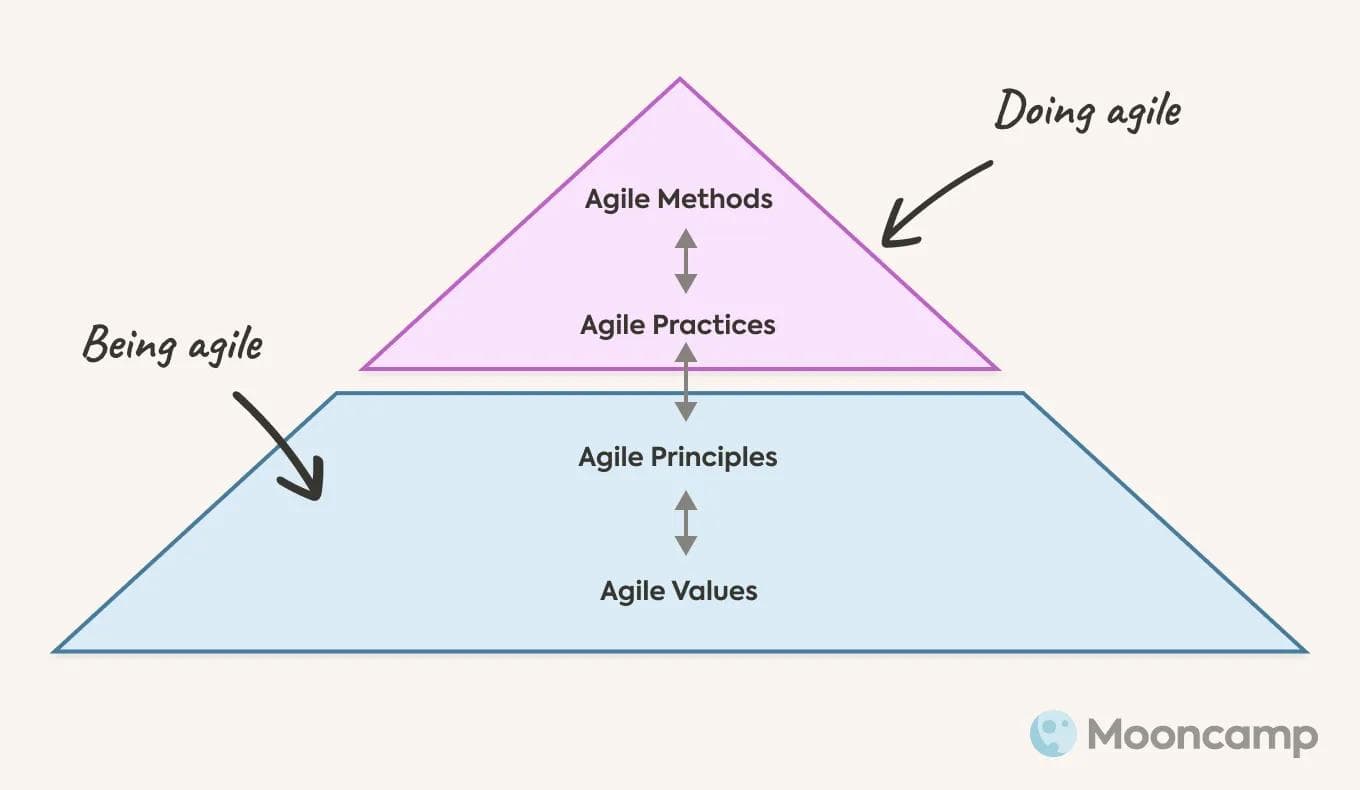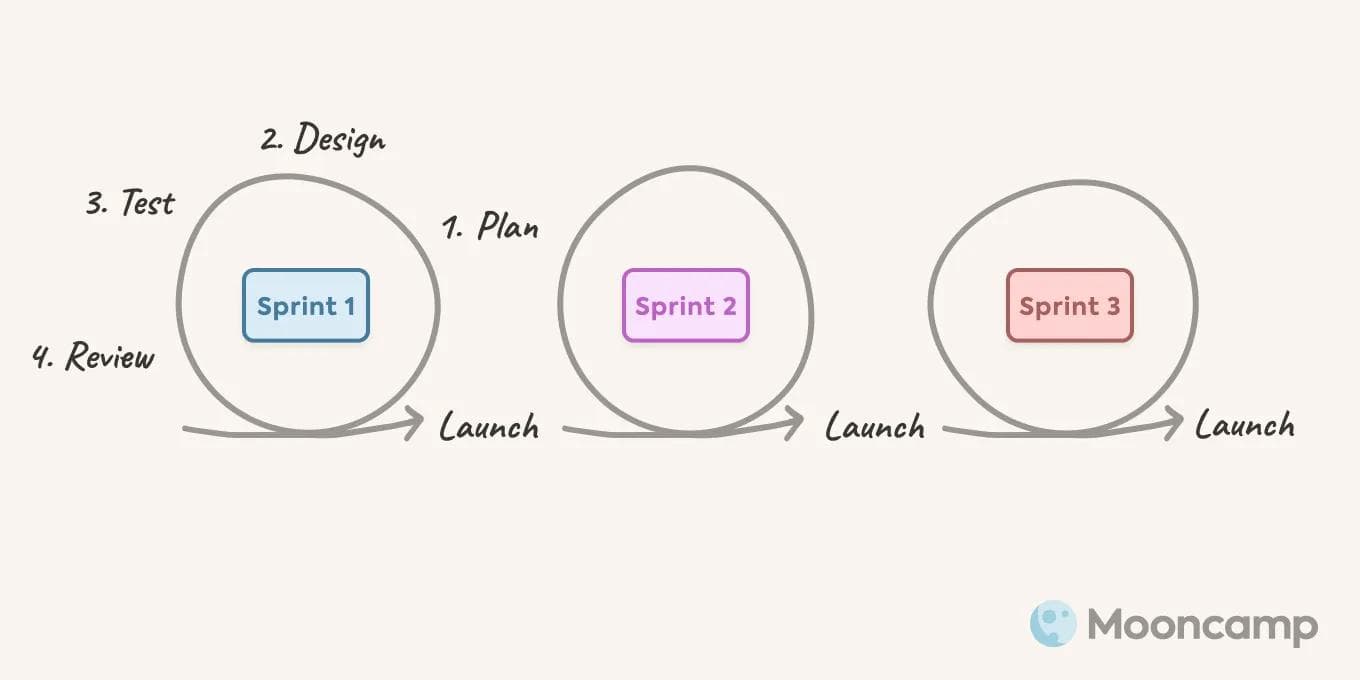Agile project management: The 2025 guide

For some years now, the term “agility” has been a hot topic in the working world – whether as “agile leadership”, ”agile projects” or ”agile project management”. Agile working is trending right now and is actually downright essential for companies to remain competitive in an increasingly fast-changing world.
However, if you take a closer look, one thing quickly becomes clear: Far too many companies are throwing around the buzzword “agile” without really having understood what agility means and how agile project management works.
To make sure this doesn't happen to you, we'll give you all the important information about agile project management in this article.
We'll take a look at what agile project management actually means, distinguish it from traditional project management, and explain which prerequisites a company needs in order to make it work.
What to expect:
- What is agile project management? Definition
- How agile project management differs from traditional project management
- How does agile project management work? Principles and values
- Requirements for successful agile project management
- Methods of agile project management
- How does agile work in practice?
- Benefits of agile project management for companies
- Conclusion: The future is agile
- Agile project management – FAQs
What is agile project management? Definition
The word “agility” describes whether and to what extent a company is capable of adapting to changes and growing with them. Behind this is a special mindset in the management of a company that is designed to respond to the challenges of everyday work in a particularly anticipatory, proactive, flexible and proactive manner.
Agile management therefore refers to a way of working that is based on flexibility, continuous improvement and adaptability. Instead of following rigid project plans, this kind of project management is about keeping work processes flexible enough at all times to be able to adapt to changing requirements or framework conditions. People and interactions are placed above processes and tools. In addition, the product and customers are in focus.
The primary goal of agile project management is to satisfy the customer. This includes developing an initial, functional version of a software, product or service as quickly as possible – and then testing and improving it together with the customer until the latter is satisfied.
In other words, agile teams achieve the optimum result through early and continuous delivery and customer feedback in a step-by-step, iterative process. In this process, the employees work in self organizing teams. Goals are set collaboratively by team members, not just determined top-down by project managers.
Where does the agile approach to work come from?
Agile working has its origins in software development: In 2001, a group of software developers met in the US state of Utah to find new and more flexible working methods for software development projects (which had been quite cumbersome until then). This resulted in an "Agile Manifesto of Software Development" with twelve agile project management principles and four guiding agile values that still shape the agile mindset today as well as being adaptable to almost any company, even outside the software cosmos.
How agile project management differs from traditional project management
What exactly distinguishes the new agile project management approach from classic workflows? The differences start with the mindset: The basis for traditional approaches is the assumption that we are able to plan all steps of a project in advance and that the working environment will not or hardly change during the implementation (you may have heard about the “waterfall model”, if not, read more in our guide about OKR, Agile & Scrum).
In fact, however, the working world today is too complex to rely on such rigid structures for project management. Agile methodology responds to the current challenges and stands out from traditional project management in the following points:
- Agile teams follow a step-by-step approach. Instead of specifying from the outset how projects should proceed or what the final product should look like, the optimal solution is being worked towards.
- Agile projects focus on the customer. They are actively involved in the development process, provide feedback at an early stage and, unlike in traditional approaches, do not get to see only the final product. This means that change requests or new discoveries can be implemented more quickly. In agile project management, a product or service is always created in close customer collaboration.
- Any changes in the course of the project are consciously accepted and taken into account. Modifications are continuously incorporated into the development of the product or service and are considered from the very beginning. This allows for a more realistic approach to budget and time.
- Agile teams work self organized. Tasks are distributed and taken on independently instead of being assigned in a classical top-down manner. Goals are also set jointly by the development team and not dictated by management.
- Being agile means continuous learning. You have to accept mistakes, analyze them, and see them as an opportunity for improvement. Agile teams have to be open to constantly learn and put previously developed solutions to the test in order to further optimize them.
How does agile project management work? Principles and values
The basis of all agile techniques and methods is the so-called “Agile Manifesto”, which we briefly mentioned above.
At this point, we will now take a closer look at its contents – and start with four agile values, without which agile project management would not be possible.
The 4 core values for agile working
- Individuals and interactions over processes and tools.
- Working software over comprehensive documentation.
- Customer collaboration over contract negotiation.
- Responding to change over following a plan.
The 12 principles of agile working
In addition to these absolute basics, the Agile Manifesto also sets out twelve principles that can be seen as a kind of guide to agile practices. Originally, these were defined for the software industry, but they can easily be applied to all kinds of industries and companies:
- The highest priority is to satisfy the customer trough early and continuous delivery.
- Welcome changing requirements, even late in development. Agile processes harness change for the customer’s competitive advantage.
- Deliver projects frequently, from a couple of weeks to a couple of months, with a preference for the shorter timescale.
- Make sure that all coordinating team members work together daily throughout the project.
- Build projects around motivated individuals. Give them the environment and support they need, and trust them to get the job done.
- The most efficient and effective method of conveying information to and within a development team is face-to-face conversation.
- The final product is the primary measure of progress.
- Agile processes promote sustainable development. Make sure that all stakeholders are able to maintain a constant pace indefinitely.
- Striving for technical excellence and good design enhances agility.
- Simplicity – the art of maximizing the amount of work not done – is essential.
- The best architectures, requirements, and designs emerge from self-organizing teams.
- At regular intervals, encourage the team to reflect on how to become more effective, then tune and adjust the behavior accordingly.

Requirements for successful agile project management
After reading the principles and values, you've probably already guessed this: Agility or agile project management is not something that you simply introduce, nor is it a state that you just achieve after a transition period. The values and principles must be applied continuously on an ongoing basis.
For this to succeed, organizations should fulfill certain requirements. These can be derived directly from the agile values and principles mentioned above.
In our opinion, these are the seven most important requirements for successful agile project management:
1. Self-organized teams
Employees can only work in a truly agile manner if they are given responsibility and if management trusts them to work independently and, within a certain scope, to make their own decisions.
2. Open communication
For successful agile project management, everyone involved in a project should be informed at all times about all processes that are relevant to them. This requires ongoing communication that is as transparent and open as possible. Regular meetings are an effective means for this, but it is even better if communication can take place on a permanent basis, preferably face-to-face or alternatively via special collaboration tools or chats.
3. Clear, shared goals and mission statements
To make agile work, there also needs to be a consistent factor between all the change and flexibility – a clear mission statement or an overarching, jointly defined goal, vision or mission – that serves as the basis for employees to make decisions during projects. Only then will everyone know why and for what they are doing their jobs.
4. Proper leadership
Leaders and project managers serve as role models and should definitely be value driven and transparent when working agile. Instead of controlling and delegating everything, they should act like a coach or mentor who gives responsibility to their employees, supports them, encourages them, and constantly reminds them of the purpose of their work. The agile workflow only works if the leadership is agile as well.
5. Adaptability
Agile project management practices are designed to be able to react quickly to changes. To do this, processes within the organization have to follow an iterative approach. The time periods in which thinking, planning, and action are taken should be shortened. Instead of planning a product from start to finish and spending ages tweaking the perfect solution, an initial valuable software or product version should be developed as quickly as possible, which is then optimized through permanent repetition (iteration) until the customer is satisfied.
6. Focus on customers
The customer's wishes are the be-all and end-all of agile project management. This does not mean that you just blindly implement what the customer says – but they should get actively involved in the development process as early as possible. Agile teams should constantly address the needs of the customer, obtain feedback on the status quo, and ask themselves: What do our customers currently want? How would they like to be positioned for the future? The expected customer value always comes first in an agile company.
7. Appropriate corporate culture
It is often underestimated how important a stable corporate culture is for agile project management. When working iteratively on products and solutions, mistakes are bound to happen. In order for the team to still dare to try out innovative approaches and take responsibility, it is important to establish an open and constructive error culture. Failure should be allowed and mistakes should be seen as an opportunity to learn.
Methods of agile project management
The above-mentioned values, principles and requirements provide the framework required to work in an agile manner.
Based on this, so-called agile project management methodologies provide the structure for the actual practical implementation – and there are quite a few of them. The most popular agile project management methods include
- Scrum
- Kanban
- Design Thinking
- Objectives and Key Results (OKRs)
- Lean

Objectives and Key Results (OKRs) can make companies more agile: With the help of transparent goals that are defined across all hierarchical levels and implemented independently by teams usually in three-month cycles.
Want to learn more about the different agile methodologies? We've got you covered! On our blog, we give you an overview of the most important agile methods.
How does agile work in practice?
Changing the way a company works to agile can be a major challenge – especially in the beginning, problems often arise or the desired successes do not materialize immediately. Many companies also find it difficult to discard their old habits.
Nevertheless, you should not be afraid to take the step towards agile working now. To help you get started, we've put together a few tips that can help you and your business become more agile, step by step:
- Analyze the initial situation and determine what your goals are. Create clarity and define what you want to achieve with agile working. Take enough time to understand what agile working really is and what an agile strategy can look like for your organization.
- Start thinking in new ways. This requires the right mindset throughout the whole organization. Leaders need to stand behind the new concept, motivate employees and give them the confidence it takes to get used to the new agile way of working.
- Put together interdisciplinary teams. Determine who will work on which tasks in which teams. Make sure that the project teams are not too large so that short decision-making and communication paths remain possible. Assign responsibility to the teams and trust them to autonomously act in the interest of the company.
- Determine which agile methods you want to work with. There are a number of methods to choose from. Take enough time to decide which agile method fits best for which team and tasks.
Benefits of agile project management for companies
Most companies have high hopes for moving towards a more agile way of working – be it more flexibility and efficiency or a better employee motivation.
Very specifically, switching to agile project management can have the following benefits:
- Better results: The quality of the results increases because the small-step, agile way of working allows you to react flexibly to changes at any time. Additionally, you carry out checks and tests repeatedly throughout the entire project period.
- Clear competitive advantage: By regularly gathering customer feedback and focusing directly on their needs, you gain a decisive advantage over companies with rigid processes.
- More motivation and productivity: Employees who work self-organized in agile teams are happier, more focused and more motivated.
- Better customer satisfaction: By working closely with customers, agile teams can better respond to their needs and develop products and services tailored to them. This ultimately makes for happier customers.
- Better employee retention: When working agilely, employees are actively involved and contribute significantly to the success of the company. This in turn strengthens employee loyalty to the company.
- Quicker time to market: Instead of fine-tuning a product or service to perfection, work is done in smaller cycles. This means that the first version of a finished product can be launched on the market more quickly.
- More openness and transparency: Structures and processes as well as goals and decisions become more transparent and comprehensible when working in an agile manner.
Conclusion: The future is agile
In summary, one can say that the modern working world is changing more and more rapidly, is becoming more digital, and therefore demands new ways of thinking and working. Agile working responds to these new challenges and enables companies to evolve and become more adaptive and resilient to changes in the market. At the same time, agile project management ensures better results, higher-motivated employees, deeper collaborative working and more satisfied customers.
So, all in all, companies that rely on agile project management are better equipped for the future.
Agile project management – FAQ
What are the 4 principles of agile?
Working agile means to put (1) individuals and interactions over processes and tools, (2) working software over comprehensive documentation, (3) customer collaboration over contract negotiation, (4) responding to change over following a plan.
What is the goal of agile project management?
The goal of agile project management is to enable a company to deal flexibly and proactively with changing conditions – while always keeping the customer and their needs in mind.
Why do companies need agility?
Companies need agility to remain competitive in an ever faster changing world and in times of digitalization, to implement customer requirements quickly and to hold their own against the competition.
What are agile project management examples?
There are a variety of agile methods. Some of the most well-known agile project management examples are Scrum, Kanban, Design Thinking, Lean and OKRs.
